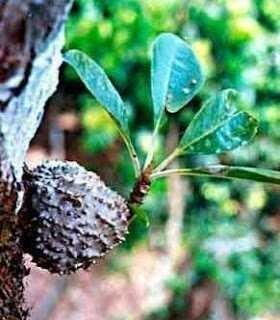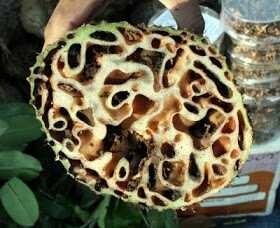Ant nest (plant)

Ants Nest is an Indonesian term for the genus myrmecodia , a genus of epiphytic mimeechophyte originating from Southeast Asia and a large archipelago extending to Queensland , Australia .
Ant nests are a collection of epiphytic plants (living on other trees, such as orchids ) of the Myrmecodia and Hydnophytum genera . Sometimes referred to as forest parasites, although this plant is actually not parasitic parasites. In English this plant is known as ' ant plant '. Hydnophytum itself comes from the Greek word ' hydnon ' meaning 'tuber' and ' phyton ' which means 'plant'. Average Myrmecodia derived from the word ' myrmekodes ' which has the meaning 'like ants' or 'full of ants'.
Ants Nest grows on branches or stems of plants. In nature, the root roots of the Ants Nest usually dangle on the branches of the plant without significant amount of substrate, thus depending on the symbiotic process for nutritional needs .
This plant delivers nutrients and water through the Bongkot grayish brown swollen and overgrown with thorns. Its thick, unbranched trunk is enclosed by klipeoli and alveoli which also contains thorns and is filled with small leaves.
In ant nest plants can be witnessed unique symbiosis , ant nest plants ( Myrmecodia spp. And Hydnophytum spp.) In addition to symbiosis with the host tree as a place to grow, ant nest trees also create a labyrinth in the trunk that became a nest and a place to live for the ants.
In addition to the unique symbiosis that occurs, the ant nest tree (especially from the genus Myrmecodia ), the stem is enlarged tuber-like turned out to be one powerful herbal medicine. 'Umbi' ant nest plants are very nutritious to cure various diseases naturally and safely.
Symbiosis in Ants Nest . As a plant empifit, ant nest symbiosis with other plants as a place to grow (host). Ant nests grow attached to several species of trees such as eucalyptus ( Melaleuca leucadendra ), pine mountain ( Casuarina junghuniana ), kaha, and beech ( Fagus spp.). But the ant nest is not a parasite, the host plant is only a place to grow it.
Ant nest plants are also symbiotic with ants (especially ants of the genus Iridomyrmex and Ochetellus ). The stem of this plant bulging like a tuber with the cavities contained in it. The cavities in the ants' mammals that resemble this labyrinth become the living and nesting ground of ants. In addition to these cavities are able to stabilize the temperature and humidity so that it becomes a convenient nest for ant colonies, this plant also produces glucose (sugar) which attracts the arrival of ants as well as ant food. Colonies of ants living in tubers or 'tubers' ant nest plants produce impurities which are then absorbed by these plants as nutrients.
